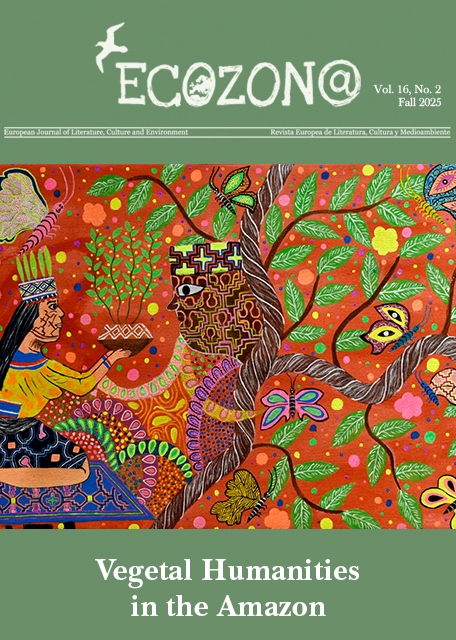<b>Impegno Ecologico: Malerba e Calvino a confronto</b> // Environmental Commitment: Malerba and Calvino // Empeño ecológico: Malerba y Calvino
DOI :
https://doi.org/10.37536/ECOZONA.2017.8.1.1003Mots-clés :
Ecocritica, ecologia, animal studies. // Ecocriticism, ecology, animal studies // Ecocrítica, ecología, estudios de los animalesRésumé
In questo saggio si svolgerà una comparazione dei tre brevi romanzi di Calvino La formica argentina (1952), La nuvola di smog (1958), La speculazione edilizia (1957), con le opere di Malerba in cui maggiormente emerge il suo impegno ecologico: Il serpente (1966), Salto mortale (1968) e Fantasmi romani (2006). Tra questi romanzi che trattano con nerbo la tematica etico-ambientale, esiste un dialogo molto forte a livello testuale e ideologico, certamente maturato dall’amicizia e dagli scambi tra i due autori. Malerba e Calvino, uomini di città cresciuti però in stretto rapporto con la campagna, si rivelano attenti osservatori dei mutamenti economici, antropologici e ambientali che l’Italia subiva nell’epoca del boom. Lontana da qualsiasi lirismo romantico e da sentimenti nostalgici per un mitico passato, la relazione tra letteratura e ambiente affiora nei testi come una forma di denuncia ecologica contro inquinamento, speculazione edilizia e sottomissione degli organismi non-umani. Sia Malerba sia Calvino si fanno portavoce della necessità di smascherare le ideologie dominanti e boicottare le logiche binarie come natura / cultura. Nella battaglia che inscenano tra umano e non-umano emerge la loro prospettiva “ecocentrica” che attribuisce un valore intrinseco ad ogni organismo vivente e al loro spazio naturale a prescindere dalla loro utilità e profitto per l’essere umano.
Abstract
This essay compares Italo Calvino’s short novels La Formica Argentina (1952), La Nuvola di Smog (1958), and La Speculazione Edilizia (1957), with Luigi Malerba’s works, in which his strong environmental consciousness most comes to light: Il Serpente (1966), Salto Mortale (1968) and Fantasmi Romani (2006). These works engage in a textual and ideological “ecocentric” dialogue about the environment and society, which was certainly the result of the close friendship and professional exchanges between the two authors. This project thus participates in ecocriticism through an investigation of the textual and ideological dialogue between these texts. Rather than merely romantic lyricism and feelings of nostalgia for the mythical past, the relationship between literature and the environment emerges in the texts as a form of ecological denunciation against pollution, building development, and the subjugation of non-human organisms. Malerba and Calvino, city men who spent their upbringing in close contact with nature, reveal themselves to be attentive observers of the economical, anthropological, and environmental changes that Italy underwent in the period known as the economic boom. Both Malerba and Calvino bring to the fore the urgency to unmask dominant ideologies and to boycott perceived binary oppositions of nature versus culture. Through these texts, they stage a battle between the human and non-human, bringing together their “ecocentric” perspective with their goal of bestowing an intrinsic value to every living organism and their natural space.
Resumen
Este ensayo compara tres novelas cortas de Italo Calvino La formica argentina (1952), La nuvola di smog (1958), La speculazione edilizia (1957), con las obras de Luigi Malerba, en las que más manifiesta su empeño ecológico: Il serpente (1966), Salto mortale (1968) e Fantasmi romani (2006). Entre estas novelas, que tratan con vigor la temática ético-medioambientalista, existe un diálogo muy fuerte a un nivel textual e ideológico, ciertamente madurado desde la amistad y los intercambios entre los dos autores. Malerba y Calvino, hombres de ciudad pero que crecieron en cercano contacto con la naturaleza, se revelan cuidadosos observadores de los mutaciones económicas, antropológicas y medioambientales que el Italia sufría en la época del boom de los años cincuenta y sesenta. Lejana de cualquier lirismo romántico y de sentimientos nostálgicos por un pasado mítico, la relación entre literatura y medio ambiente aparece en los textos como una forma de denuncia ecológica contra la contaminación, la especulación edil y la sumisión de los organismos no-humanos. Tanto Malerba como Calvino devienen portavoces de la necesitad de desenmascarar las ideologías dominantes y boicotear las lógicas binarias como naturaleza / cultura. En la lucha que escenifican entre el humano y no-humano emerge su perspectiva “ecocéntrica” que atribuye un valor intrínseco a cada organismo viviente y a su espacio natural sin importar los beneficios económicos.
Téléchargements
Téléchargements
Publié-e
Numéro
Rubrique
Licence
Authors who publish with this journal agree to the following terms:
a) Authors retain copyright and grant the journal right of first publication with the work simultaneously licensed under a Creative Commons Attribution License that allows others to share the work with an acknowledgement of the work's authorship and initial publication in this journal (CC BY-NC for articles and CC BY-NC-ND for creative work, unless author requests otherwise.
b) Authors are able to enter into separate, additional contractual arrangements for the non-exclusive distribution of the journal's published version of the work (e.g., post it to an institutional repository or publish it in a book), with an acknowledgement of its initial publication in this journal.
c) Authors are permitted and encouraged to post their work online (e.g., in institutional repositories or on their website) prior to and during the submission process, as it can lead to productive exchanges, as well as earlier and greater citation of published work (See The Effect of Open Access).










